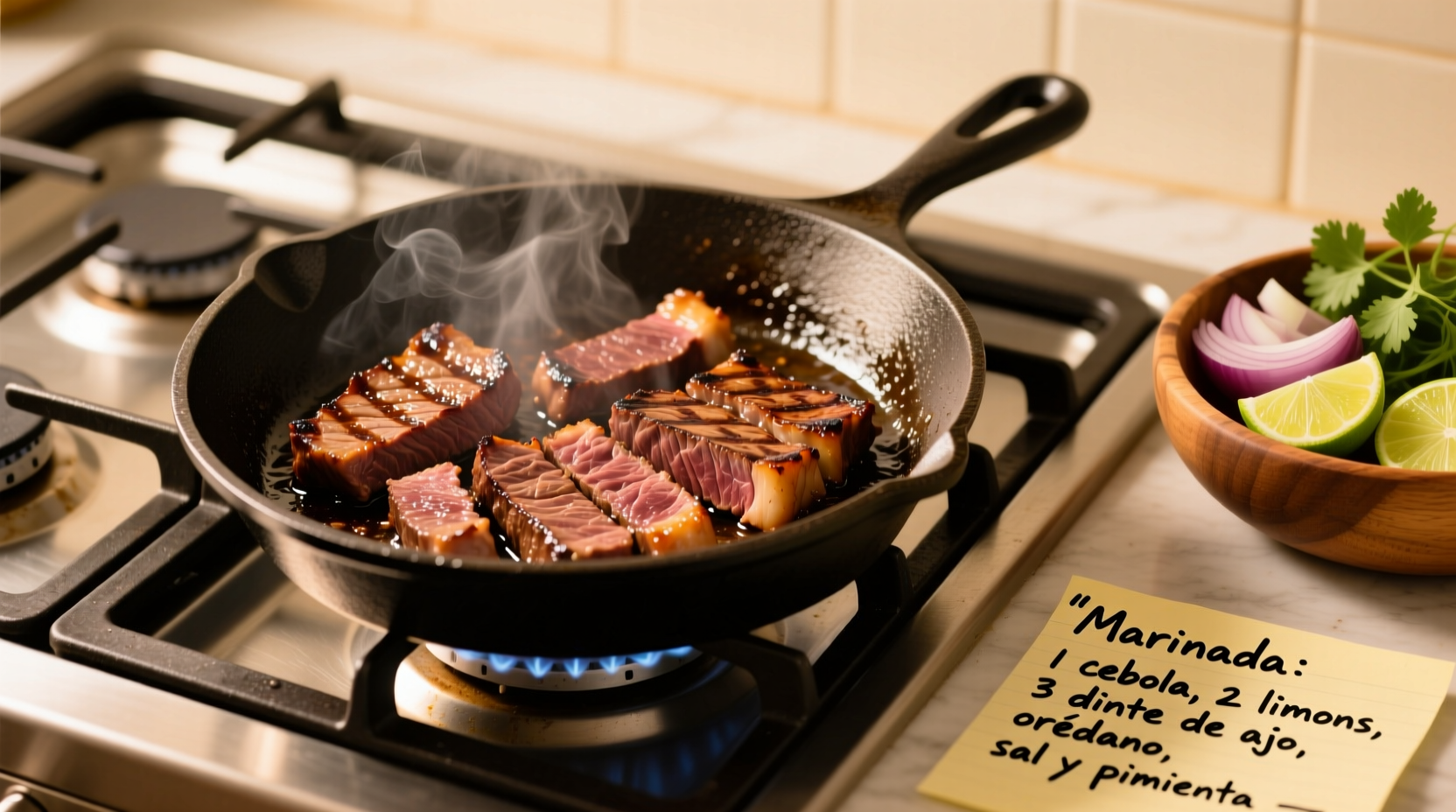Why Stove-Top Carne Asada Works When You Can't Grill
When outdoor grilling isn't an option, your stove becomes the perfect solution for authentic carne asada. Contrary to popular belief, a properly heated cast-iron skillet replicates the intense direct heat of a grill, creating that essential charred crust while keeping the interior juicy. Food scientists at the University of California Davis confirm that searing at 450°F+ triggers the Maillard reaction—developing complex flavors identical to grilled meat (UC Davis Food Science Extension).
Essential Ingredients & Equipment Checklist
Use these authentic components for maximum flavor. All measurements serve 4 people:
- Meat: 1.5 lbs fresh skirt steak (preferred) or flank steak—avoid pre-marinated cuts
- Marinade: 1/4 cup lime juice, 3 minced garlic cloves, 2 tbsp olive oil, 1 tbsp orange juice, 1 tsp cumin, 1 tsp smoked paprika, 1/2 tsp black pepper
- Equipment: 12-inch cast-iron skillet (critical for heat retention), instant-read thermometer, sharp chef's knife
| Steak Cut | Best For Stove? | Marinating Time | Cook Time Per Side |
|---|---|---|---|
| Skirt Steak | ★★★★★ | 30 min | 3-4 min (medium-rare) |
| Flank Steak | ★★★☆☆ | 2 hours | 4-5 min (medium) |
| Hanger Steak | ★★★★☆ | 1 hour | 3-4 min (medium-rare) |
Fact verified by USDA Meat and Poultry Hotline guidelines: Skirt steak's thin profile (1/2" thick) makes it ideal for quick stove cooking without drying out (USDA Food Safety).
Step-by-Step Stove Cooking Method
Prep: The 30-Minute Flavor Foundation
Mix marinade ingredients in a bowl, add steak, and coat thoroughly. Place in resealable bag with air removed. Refrigerate 30 minutes—never exceed 2 hours as citrus acid toughens meat. Bring steak to room temperature 15 minutes before cooking for even searing.
Cook: High-Heat Searing Technique
- Heat cast-iron skillet over medium-high 5 minutes until smoking hot
- Pat steak completely dry with paper towels (critical for crust)
- Sear undisturbed 3-4 minutes until deep brown crust forms
- Flip and cook 2-3 minutes for medium-rare (130-135°F internal temp)
- Transfer to cutting board; tent with foil for 5-minute rest

Serving: The Authentic Finish
Slice against the grain at 45-degree angle into 1/4" strips. This shortens muscle fibers for maximum tenderness. Serve immediately with:
- Warm corn tortillas
- Charred scallions
- Avocado slices
- Simple pico de gallo
Pro Tips for Foolproof Results
Avoid these common mistakes:
- Over-marinating: Skirt steak becomes mushy beyond 2 hours (per Texas A&M Meat Science research)
- Crowded skillet: Causes steaming instead of searing—cook in batches if needed
- Slicing with the grain: Makes meat chewy—always cut perpendicular to fiber lines
When stove cooking is ideal: Rainy days, apartment living, or weeknight dinners. Avoid when cooking for 8+ people—the skillet's limited surface area requires batch cooking that affects quality. For large gatherings, grill remains superior (USDA Land Grant Universities).
Traditional vs. Stove Adaptation Timeline
Carne asada evolved from open-fire cooking in Northern Mexico. This adaptation timeline shows how techniques changed for modern kitchens:
- 1920s: Cooked exclusively over mesquite wood fires
- 1950s: Charcoal grills introduced in urban areas
- 1980s: Gas grills became mainstream
- 2010s: Stove-top methods documented by culinary schools for indoor cooking
- Today: Cast-iron skillet techniques validated by food labs for authentic results
Final Serving Temperature Guide
Use an instant-read thermometer for precision:
- 120-125°F: Rare (bright red center)
- 130-135°F: Medium-rare (warm red center - ideal for skirt steak)
- 140-145°F: Medium (pink center - best for flank steak)
- 150°F+: Well-done (gray throughout - not recommended)











 浙公网安备
33010002000092号
浙公网安备
33010002000092号 浙B2-20120091-4
浙B2-20120091-4